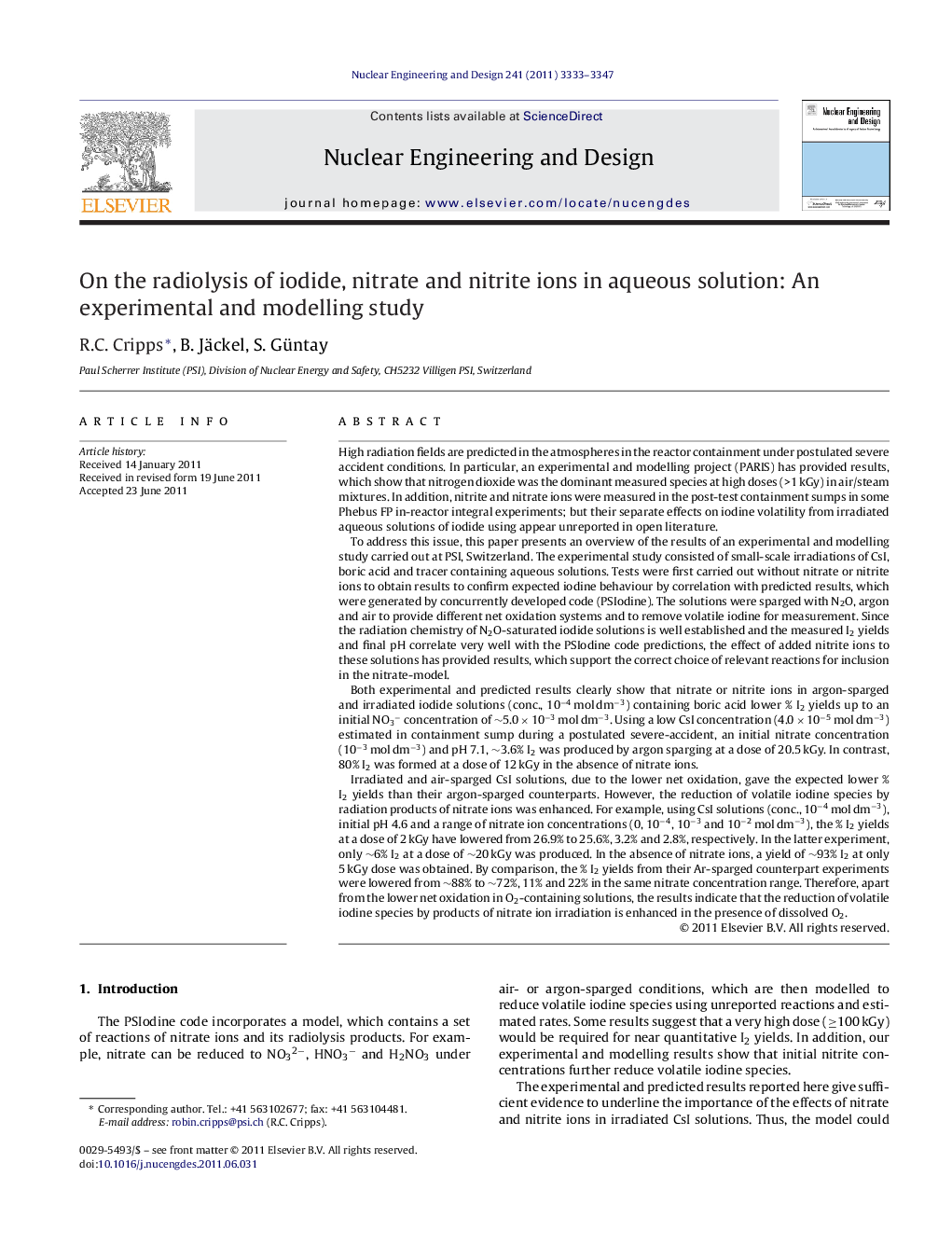| کد مقاله | کد نشریه | سال انتشار | مقاله انگلیسی | نسخه تمام متن |
|---|---|---|---|---|
| 297451 | 511756 | 2011 | 15 صفحه PDF | دانلود رایگان |

High radiation fields are predicted in the atmospheres in the reactor containment under postulated severe accident conditions. In particular, an experimental and modelling project (PARIS) has provided results, which show that nitrogen dioxide was the dominant measured species at high doses (>1 kGy) in air/steam mixtures. In addition, nitrite and nitrate ions were measured in the post-test containment sumps in some Phebus FP in-reactor integral experiments; but their separate effects on iodine volatility from irradiated aqueous solutions of iodide using appear unreported in open literature.To address this issue, this paper presents an overview of the results of an experimental and modelling study carried out at PSI, Switzerland. The experimental study consisted of small-scale irradiations of CsI, boric acid and tracer containing aqueous solutions. Tests were first carried out without nitrate or nitrite ions to obtain results to confirm expected iodine behaviour by correlation with predicted results, which were generated by concurrently developed code (PSIodine). The solutions were sparged with N2O, argon and air to provide different net oxidation systems and to remove volatile iodine for measurement. Since the radiation chemistry of N2O-saturated iodide solutions is well established and the measured I2 yields and final pH correlate very well with the PSIodine code predictions, the effect of added nitrite ions to these solutions has provided results, which support the correct choice of relevant reactions for inclusion in the nitrate-model.Both experimental and predicted results clearly show that nitrate or nitrite ions in argon-sparged and irradiated iodide solutions (conc., 10−4 mol dm−3) containing boric acid lower % I2 yields up to an initial NO3− concentration of ∼5.0 × 10−3 mol dm−3. Using a low CsI concentration (4.0 × 10−5 mol dm−3) estimated in containment sump during a postulated severe-accident, an initial nitrate concentration (10−3 mol dm−3) and pH 7.1, ∼3.6% I2 was produced by argon sparging at a dose of 20.5 kGy. In contrast, 80% I2 was formed at a dose of 12 kGy in the absence of nitrate ions.Irradiated and air-sparged CsI solutions, due to the lower net oxidation, gave the expected lower % I2 yields than their argon-sparged counterparts. However, the reduction of volatile iodine species by radiation products of nitrate ions was enhanced. For example, using CsI solutions (conc., 10−4 mol dm−3), initial pH 4.6 and a range of nitrate ion concentrations (0, 10−4, 10−3 and 10−2 mol dm−3), the % I2 yields at a dose of 2 kGy have lowered from 26.9% to 25.6%, 3.2% and 2.8%, respectively. In the latter experiment, only ∼6% I2 at a dose of ∼20 kGy was produced. In the absence of nitrate ions, a yield of ∼93% I2 at only 5 kGy dose was obtained. By comparison, the % I2 yields from their Ar-sparged counterpart experiments were lowered from ∼88% to ∼72%, 11% and 22% in the same nitrate concentration range. Therefore, apart from the lower net oxidation in O2-containing solutions, the results indicate that the reduction of volatile iodine species by products of nitrate ion irradiation is enhanced in the presence of dissolved O2.
► Nitrate lowers volatile iodine yields in irradiated and Ar-sparged CsI solutions.
► Radiolysis products (NO32−, HNO3− and H2NO3) reduce volatile iodine species.
► Iodine reduction by radiolysis products is enhanced by dissolved O2.
► N2O-sparged and irradiated CsI solutions with nitrite ions support new reactions.
► Evidence shows importance of nitrate and nitrite ions in iodine radiolysis.
Journal: Nuclear Engineering and Design - Volume 241, Issue 8, August 2011, Pages 3333–3347